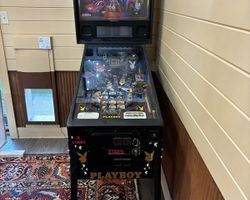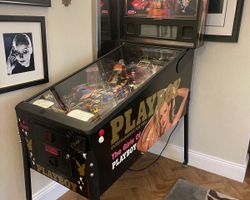Playboy®

Average Prices: USD $1,000 to $3,600
Produced: January, 2002
Machine Type: Solid State Electronic
MPU: Sega/Stern Whitestar
Players: 4
Concept by: Dwight Sullivan, George Gomez
Design by: Dwight Sullivan, George Gomez
Art by: Kevin OConnor
Dots/Animation by: Mark Galvez
Mechanics by: George Gomez, Wesley Chang
Music by: Kyle Johnson
Sound by: Kyle Johnson
Software by: Dwight Sullivan, Orin Day, Lonnie D. Ropp
The pinball machine "Playboy" by Stern Pinball, Inc., released in January 2002, stands as a distinct entry in the manufacturer's early 2000s catalog. Produced in a run of 1,400 units, this solid-state electronic (SS) machine operates on the Sega/Stern Whitestar MPU platform, a common foundation for Stern titles during that period. The game's theme, directly licensed from the adult entertainment brand, was central to its design and subsequent reception, aiming for an audience interested in a mature-themed pinball experience.
The design of Playboy was a collaborative effort, with Dwight Sullivan and George Gomez sharing design and concept responsibilities. Gomez also contributed to the machine’s mechanical engineering alongside Wesley Chang. Kevin O'Connor crafted the artwork, giving the machine its visual identity. Software development was handled by Dwight Sullivan, Lonnie D. Ropp, and Orin Day, while Mark Galvez managed the animations displayed on the dot matrix display. The auditory landscape of the game, including music and sound effects, was created by Kyle Johnson. A notable aspect of its production was the inclusion of interchangeable playfield picture sets, offering operators choices ranging from lingerie to topless or nude imagery, a feature that allowed for customization of the machine's overt theme presentation. The cabinet itself was advertised with specific dimensions, standing 75 1/2 inches high, 27 inches wide, and 55 inches long, weighing approximately 260 pounds.
Signature Features and Design
"Playboy" incorporates several distinct mechanical features that directly integrate with its theme, enhancing both visual appeal and gameplay interaction. A prominent unfolding centerfold assembly dominates the playfield, designed to reveal imagery as game objectives are met. This toy acts as a centerpiece, drawing attention and providing a tangible reward for successful shots. Another engaging element is the drop-down "Tease" screen, strategically positioned to lower incrementally with each hit to the pop bumpers. This gradual reveal builds anticipation, exposing more of a hidden photograph over time.
Further enhancing the visual reveals, a "Peek-a-Boo" beaded curtain, utilizing a magnetic mechanism, can be drawn to uncover a model, creating a dynamic visual effect during gameplay. An opening magazine toy also contributes to the thematic progression, simulating the act of viewing content within a publication. A three-sided rotating photo board adds another layer of visual interaction, presenting different images depending on game progression or player achievement. These features, along with specific artwork elements by Kevin O'Connor, are meticulously woven into the playfield design, ensuring that the machine's adult theme is consistently present through its interactive elements and visual composition. The integration of these toys directly tied gameplay progression to the revealing nature of the Playboy brand, making the theme an active part of the pinball experience.
Playfield and Mechanics
The playfield of "Playboy" by Stern is structured around a multi-leveled layout, featuring a manual plunger for ball launch. The primary playfield incorporates two flippers for shot execution. A key element of the layout is the presence of three distinct ramps, providing varied shot opportunities and leading to different sections or scoring objectives on the upper levels or return paths. The design ensures a degree of flow, allowing players to string together combinations of shots.
Three pop bumpers are strategically placed to activate the "Tease" screen feature, incrementally lowering it as they are repeatedly hit. A single drop target is integrated into the playfield, offering a specific target challenge that can lead to mode activations or point accumulation. The artwork, while aiming to complement the licensed theme, has been subject to varied opinions regarding its vibrancy and depth. Lighting is utilized to highlight active shots, indicate mode progression, and draw attention to the various revealing toys, complementing the visual design by emphasizing key interactive elements. The overall aesthetic of the playfield is designed to immerse the player in the Playboy theme, with interactive components guiding the player through a progression of visual reveals and scoring opportunities. The layout’s philosophy supports direct shots towards these theme-centric mechanisms, encouraging players to engage with the core features.
Gameplay Dynamics
"Playboy" offers a gameplay experience centered on its thematic progression, driven by completing objectives tied to the machine's unique features. The game features a 4-ball multiball, providing a high-energy scoring opportunity that allows players to juggle multiple balls simultaneously for increased points and mode advancement. Gameplay progression often revolves around lighting inserts and completing targets to "collect playmates" or advance through different pictorial reveals. For instance, repeatedly hitting the pop bumpers gradually lowers the "Tease" screen, revealing more of a photograph and contributing to overall progress. Activating the magnetic curtain and unfolding the centerfold assembly are also key objectives, unlocking points and visual rewards.
Skill shots are integrated into the ball launch, offering initial strategic choices for players seeking to maximize their opening points or activate specific game advantages. The scoring system, however, has been noted for its imbalance, with certain features or shot sequences yielding disproportionately high points. This can lead to players focusing on a narrow set of objectives, potentially making gameplay repetitive for some. Despite this, the game’s various modes and objectives, such as lighting specific targets or hitting the ramps in sequence, are designed to encourage exploration of the playfield and engagement with the theme's interactive elements. The ultimate goal often culminates in accessing and completing the game's various pictorial reveals and achieving multiball, which serve as central highlights of the experience.
Reception and Legacy
"Playboy" by Stern has elicited a spectrum of opinions within the pinball community, resulting in a mixed reception. Among its perceived strengths, many players point to the game's playfield layout, describing it as well-designed with a satisfying flow and a good variety of shots and ramps. The integration of the Playboy theme is often cited as a strong point for those who appreciate its niche, particularly in home environments. Reviewers have highlighted the effectiveness of toys such as the peek-a-boo curtain and the unfolding centerfold, finding these unique mechanisms entertaining and well-implemented within the theme. The presence of engaging skill shots also contributes to its appeal for some. For casual play, the machine is often regarded as enjoyable and straightforward.
However, the machine also faces significant criticism. The theme itself is a central point of contention; many find it dated, overly simplistic, or unsuitable for public play due to its explicit nature. This aspect often overshadows other design elements for a segment of the audience. From a gameplay perspective, some players find "Playboy" to be too easy, lacking the depth and challenge that encourages prolonged engagement. This perceived lack of depth can lead to the game feeling repetitive or boring after a limited number of plays. The quality of the artwork has been described as uninspired by some, while the sounds and music are frequently criticized for being cheesy, annoying, or unmemorable, failing to contribute positively to the overall experience. Concerns regarding scoring imbalance are common, with certain strategies dominating high scores, which can detract from varied gameplay. The middle drain, a common pinball challenge, is noted by some as particularly unforgiving on this machine, leading to frustratingly short ball times.
Despite the divided opinions, "Playboy" holds a place as an example of Stern's approach to licensed adult themes in the early 2000s. Its legacy is not one of broad influence on future machine design, but rather as a conversation piece and a demonstration of how a theme can profoundly shape a machine's appeal and longevity. For some, it remains an underrated machine that offers straightforward fun, while for others, its thematic choices and perceived gameplay limitations prevent it from achieving a more esteemed status. It stands as a unique entry, appealing strongly to a specific segment of collectors and enthusiasts while generating a lukewarm response from others who prioritize gameplay depth or broader thematic appeal.
Sponsored Links
 Ebay Listings
Ebay Listings
 Auction Results
Auction Results
| Cost | Location | Date |
|---|---|---|
| USD $5,650 |  California, United States California, United States |
06 September, 2025 |
| USD $7,000 |  Tennessee, United States Tennessee, United States |
04 September, 2025 |
| USD $1,650 |  Ohio, United States Ohio, United States |
06 February, 2025 |
| EUR €2,750 |  Niedersachsen, Germany Niedersachsen, Germany |
08 November, 2024 |
| USD $3,600 |  Tennessee, United States Tennessee, United States |
20 June, 2024 |
| USD $4,100 |  Tennessee, United States Tennessee, United States |
20 June, 2024 |
| GBP £3,850 |  United Kingdom United Kingdom |
21 March, 2024 |
| USD $4,900 |  Florida, United States Florida, United States |
14 March, 2024 |
| GBP £3,850 |  United Kingdom United Kingdom |
13 March, 2024 |
| USD $8,000 |  Washington, United States Washington, United States |
22 August, 2023 |


Private Policy · Search Website · Contact Us
As an eBay Partner, we may earn a commission from qualifying purchases made through links on this site, at no additional cost to you.
All trademarks and copyrighted materials remain property of their respective owners. All other content copyright 2007 - 2025 Pinpedia.







